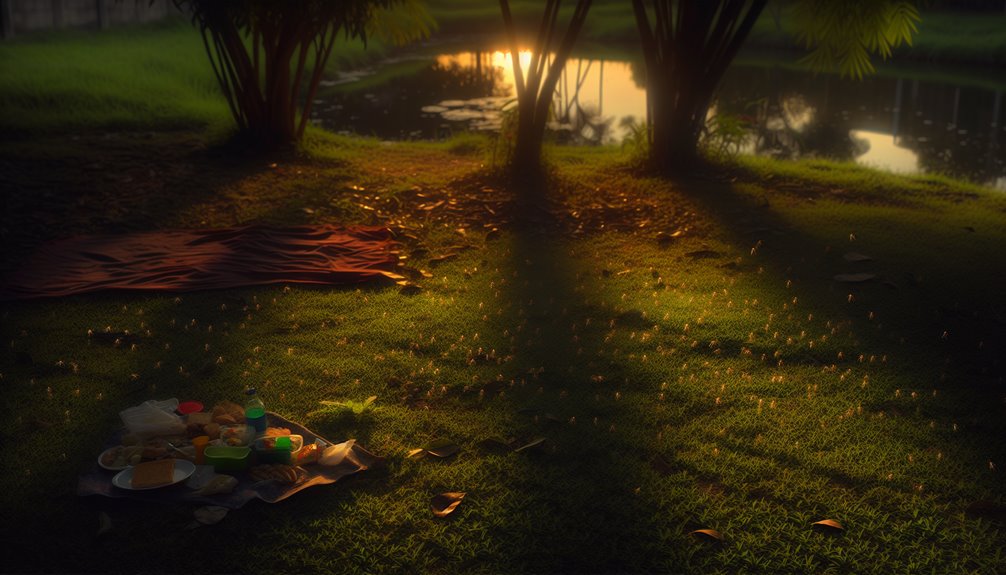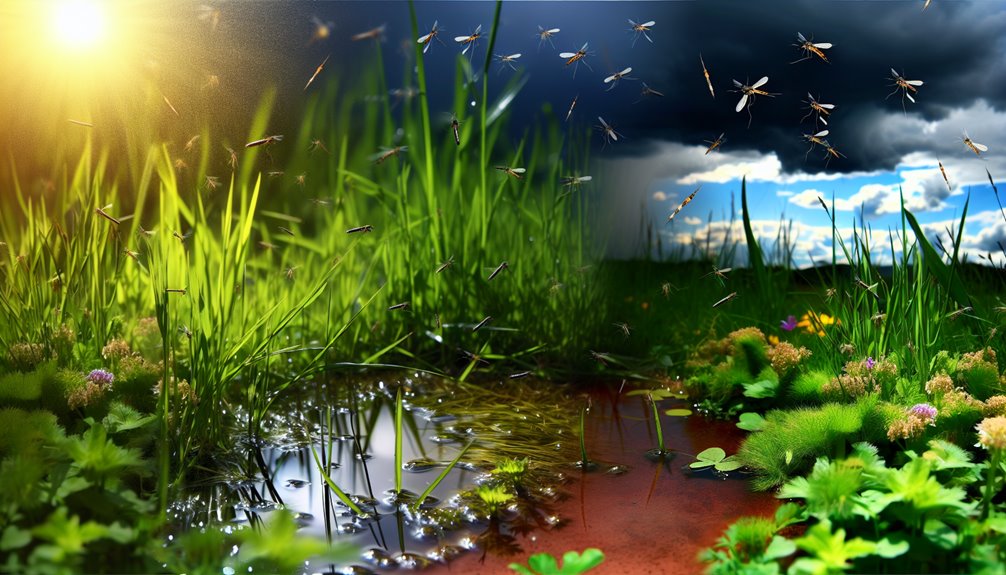If you’re noticing more bites at dusk, pets acting restless, and puddles that don’t dry, your yard may be inviting mosquitoes. Overgrown shrubs and shaded, humid corners can amplify the problem, especially after warm, wet weather. You’ve likely tried dumping water and trimming vegetation, but persistent activity signals a larger issue. Knowing when DIY is enough—and when regulations and safety call for licensed treatment—can protect your family and stay compliant with local rules.
Sudden Spikes in Bites, Especially at Dusk and Dawn

If you notice a sharp increase in mosquito bites at dusk and dawn, your yard likely supports active breeding or resting sites that require prompt treatment. These peak times align with mosquito behavior: many species seek hosts in low light, elevating bite frequency. Track patterns—location, timing, and weather—to document risk and protect those you serve. Wear EPA-registered repellent, reduce outdoor exposure at crepuscular hours, and make sure screens close properly. If bites escalate within days, or vulnerable people are affected, contact a licensed provider. Request an inspection, species identification, and an integrated management plan that meets local regulations and safety standards.
Standing Water That Sticks Around After Rain or Irrigation
Beyond bite patterns, persistent standing water is the strongest indicator your yard needs treatment and source reduction. If puddles linger 3–7 days after rain or irrigation, you’re likely incubating mosquitoes. Check low spots, clogged gutters, birdbaths, planters, playsets, and tarps. Empty, scrub, or remove containers weekly. For ponds, prioritize pond maintenance: circulate water, maintain skimmers, and apply EPA-registered larvicides as labeled. Improve grade and direct downspouts to permeable areas. Install drainage solutions—French drains, dry wells, or swales—where runoff collects. Document your actions. If water still persists, schedule a licensed professional inspection and treatment to protect neighbors and meet local codes.
Overgrown Landscaping and Shady, Humid Zones

Though larvae develop in water, adult mosquitoes rest in dense, shaded vegetation where humidity stays high. When your yard has overgrown vegetation, tangled shrubs, or low-hanging branches, you create humid microclimates that shelter daytime-resting adults. You’ll notice increased mosquito activity when you step into these cool, still pockets.
Trim hedges to allow airflow, thin groundcovers, and raise tree canopies to reduce shade density. Bag clippings promptly, and keep mulch no deeper than three inches. Verify local regulations before altering buffers or protected areas. If dense shade persists near entries or play areas, schedule a compliant treatment plan to protect your household and guests.
Pet Restlessness and Increased Backyard Scratching
Shaded, humid pockets don’t just shelter adult mosquitoes—they also make your pets miserable. If you notice restless pacing, sudden dashes indoors, or persistent licking, you’re observing pet behavior consistent with active mosquito pressure. Bites trigger itchy skin, secondary infections, and hot spots, especially around ears, belly, and tail base. Check dusk and dawn patterns; if pets refuse certain corners or scratch after brief outings, your yard’s likely a source. Document frequency, use veterinarian-approved preventives, and remove standing water. If relief stalls after basic sanitation and barrier steps, call a licensed mosquito control provider to assess, treat compliantly, and monitor results.
Weather Patterns That Supercharge Mosquito Breeding

When warm rains arrive in quick bursts and the air stays humid, you’ve got ideal conditions for mosquitoes to explode in number. Short downpours leave shallow pools and clogged gutters, creating a perfect breeding habitat. Rising night temperatures accelerate larvae development, and calm mornings boost mosquito activity at ground level. You serve your household and neighbors by recognizing these patterns early and acting within local guidelines.
- http___www.bigleaguekickball.com_about_ Soma online ordering next day VISA Mastercard accepted Heavy rain followed by heat: rapid egg-to-adult cycles.
- High humidity: longer adult survival and biting windows.
- Stagnant water pockets: hidden breeding habitat in containers.
- Warm nights with little wind: peak mosquito activity near people.
DIY Controls That Work—and When It’s Time to Call a Pro
Spotting those rain-and-heat patterns is only half the battle; now you need controls you can apply safely and effectively. Start by eliminating standing water weekly, including trays, tarps, gutters, and toys. Use EPA-registered larvicides in birdbaths and drains per label directions. Run fans during gatherings; mosquitoes fly poorly in moving air. Apply personal protection—long sleeves and EPA-approved repellents; consider natural repellents like oil of lemon eucalyptus where appropriate.
Call a licensed pest control professional when bites persist after source reduction, you’ve got dense vegetation, water features you can’t drain, or community complaints. Pros assess habitats, apply targeted treatments, and document compliance.
Conclusion
As the owner of Mosquito Eliminators of South MS, I truly understand how frustrating it can be to deal with pesky mosquitoes taking over your outdoor space. It’s not just about the bites; it’s about enjoying your yard with family and friends. If you notice those unwelcome guests buzzing around, don’t hesitate to reach out. We’re here to help you reclaim your personal oasis! I encourage you to visit our website at mosquitoeliminatorsms.com or give us a call at (601) 336-2277. Together, we can ensure your summer stays safe and enjoyable, free from those annoying intruders. Let’s make your yard a peaceful haven again!

